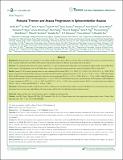| dc.identifier.citation | Gan, S., J. Wang, K. P. Figueroa, S. M. Pulst, D. Tomishon, D. Lee, S. Perlman, et al. 2017. “Postural Tremor and Ataxia Progression in Spinocerebellar Ataxias.” Tremor and Other Hyperkinetic Movements 7 (1): 492. doi:10.7916/D8GM8KRH. http://dx.doi.org/10.7916/D8GM8KRH. | en |
| dc.description.abstract | Background: Postural tremor can sometimes occur in spinocerebellar ataxias (SCAs). However, the prevalence and clinical characteristics of postural tremor in SCAs are poorly understood, and whether SCA patients with postural tremor have different ataxia progression is not known. Methods: We studied postural tremor in 315 patients with SCA1, 2, 3, and 6 recruited from the Clinical Research Consortium for Spinocerebellar Ataxias (CRC-SCA), which consists of 12 participating centers in the United States, and we evaluated ataxia progression in these patients from January 2010 to August 2012. Results: Among 315 SCA patients, postural tremor was most common in SCA2 patients (SCA1, 5.8%; SCA2, 27.5%; SCA3, 12.4%; SCA6, 16.9%; p = 0.007). SCA3 patients with postural tremor had longer CAG repeat expansions than SCA3 patients without postural tremor (73.67 ± 3.12 vs. 70.42 ± 3.96, p = 0.003). Interestingly, SCA1 and SCA6 patients with postural tremor had a slower rate of ataxia progression (SCA1, β = –0.91, p < 0.001; SCA6, β = –1.28, p = 0.025), while SCA2 patients with postural tremor had a faster rate of ataxia progression (β = 1.54, p = 0.034). We also found that the presence of postural tremor in SCA2 patients could be influenced by repeat expansions of ATXN1 (β = –1.53, p = 0.037) and ATXN3 (β = 0.57, p = 0.018), whereas postural tremor in SCA3 was associated with repeat lengths in TBP (β = 0.63, p = 0.041) and PPP2R2B (β = –0.40, p = 0.032). Discussion Postural tremor could be a clinical feature of SCAs, and the presence of postural tremor could be associated with different rates of ataxia progression. Genetic interactions between ataxia genes might influence the brain circuitry and thus affect the clinical presentation of postural tremor. | en |


